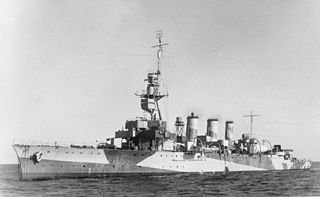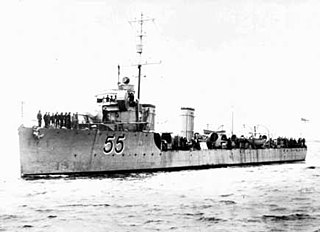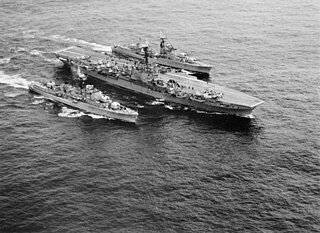
HMAS Adelaide was a Town-class light cruiser of the Royal Australian Navy (RAN), named after Adelaide, the capital city of South Australia. Laid down in 1915, wartime shortages and design modifications meant the ship was not completed until 1922, earning her the nickname "HMAS Longdelayed".

HMAS Quadrant (G11/D11/F01), named for the navigational instrument, was a Q-class destroyer operated by the Royal Navy as HMS Quadrant (G67/D17) during World War II, and the Royal Australian Navy (RAN) from 1945 to 1957. The ship was built during the early 1940s as one of the War Emergency Programme destroyers, and entered service in 1942.

HMAS Encounter was a second-class protected cruiser of the Challenger class operated by the Royal Navy (RN) and Royal Australian Navy (RAN). She was built by HM Dockyard Devonport and completed at the end of 1905.

HMAS Parramatta, named after the Parramatta River, was a River-class torpedo-boat destroyer of the Royal Australian Navy (RAN). Ordered in 1909 for the Commonwealth Naval Forces, Parramatta was the first ship launched for the RAN. Temporarily commissioned into the Royal Navy for the delivery voyage to Australia, the destroyer came under Australian naval control in 1910, and was recommissioned into the RAN on 1 March 1911, shortly before the latter's formal creation.

HMAS Parramatta, named for the Parramatta River, was a River-class destroyer escort of the Royal Australian Navy (RAN).

HMAS Stuart was a British Scott-class flotilla leader. The ship was built by Hawthorn Leslie and Company for the Royal Navy during World War I, and entered service at the end of 1918. The majority of the destroyer's British service was performed in the Mediterranean, and in 1933 she was transferred to the Royal Australian Navy. Although placed in reserve in 1938, Stuart was reactivated at the start of World War II to lead the Australian destroyer force, nicknamed the "Scrap Iron Flotilla" by German propagandists.

HMAS Swan, named for the Swan River, was a River-class destroyer escort of the Royal Australian Navy (RAN). Constructed in Melbourne following the loss of HMAS Voyager, Swan entered service in 1970.

HMAS Sydney was a Chatham-class light cruiser of the Royal Australian Navy (RAN). Laid down in 1911 and launched in 1912, the cruiser was commissioned into the RAN in 1913.

HMAS Anzac (D59) was a Battle-class destroyer of the Royal Australian Navy (RAN). Named after the Australian and New Zealand Army Corps, the destroyer was commissioned in 1951. The ship served on two tours of duty during the Korean War, and attempts to distinguish herself from British ships led to the practice of red kangaroo symbols on Australian warships. During 1956, Anzac served during the Malayan Emergency. In 1960, a malfunction in the destroyer's gun direction equipment caused Anzac to fire directly on sister ship HMAS Tobruk during a gunnery exercise, with Tobruk left unrepairable. In 1961, the destroyer was reclassified as a training vessel. Anzac remained in service until 1974, and was sold for breaking a year later.

HMAS Brisbane was a Town class light cruiser of the Royal Australian Navy (RAN). Built in Sydney between 1913 and 1916 to the Chatham subtype design, Brisbane operated in the Indian Ocean, Pacific Ocean, and Australian coastal waters during World War I.

HMAS Canberra (I33/D33), named after the Australian capital city of Canberra, was a Royal Australian Navy (RAN) heavy cruiser of the Kent sub-class of County-class cruisers. Constructed in Scotland during the mid-1920s, the ship was commissioned in 1928, and spent the first part of her career primarily operating in Australian waters, with some deployments to the China Station.

HMAS Vampire was the third of three Australian-built Daring class destroyers serving in the Royal Australian Navy (RAN). One of the first all-welded ships built in Australia, she was constructed at Cockatoo Island Dockyard between 1952 and 1959, and was commissioned into the RAN a day after completion.

HMAS Voyager was a Daring-class destroyer of the Royal Australian Navy (RAN), that was lost in a collision in 1964.

HMAS Vendetta was one of three Daring-class destroyers built for and operated by the Royal Australian Navy (RAN). The destroyer was built by Williamstown Naval Dockyard and entered service in 1958. During her early career, Vendetta was deployed to the Far East Strategic Reserve on multiple occasions. In 1965 and 1966, the destroyer undertook deterrence patrols during the Indonesia-Malaysia Confrontation. Along with several runs escorting the troop transport HMAS Sydney to South Vietnam, from late 1969 to early 1970 Vendetta was assigned to combat operations and became the only Australian-built warship to serve in a shore bombardment role during the Vietnam War.

HMAS Vendetta (D69/I69) was a V-class destroyer that served in the Royal Navy and the Royal Australian Navy (RAN). One of 25 V class ships ordered for the Royal Navy during World War I, Vendetta entered service in 1917.

HMAS Derwent, named for the Derwent River, was a River-class destroyer escort of the Royal Australian Navy (RAN). She was laid down by Williamstown Naval Dockyard in 1959, and commissioned into the RAN in 1964. During the ship's career, she was deployed to South East Asia on 23 occasions, including operations during the Indonesia-Malaysia Confrontation, and escort of the troopship HMAS Sydney to and from the Vietnam War. Multiple flag-showing cruises were also embarked upon, with port visits throughout Asia, the Indian Ocean, and the Pacific Ocean. Derwent was also briefly used to portray a fictional vessel for the British drama series Warship.

HMAS Gladstone (J324/M324), named for the city of Gladstone, Queensland, was one of 60 Bathurst class corvettes constructed during World War II, and one of 36 that were initially manned and commissioned solely by the Royal Australian Navy (RAN). Built by Walkers Limited, the ship was commissioned in 1943.

The BL 6-inch Mark XI naval gun was a British 50 calibres high-velocity naval gun which was mounted as primary armament on cruisers and secondary armament on pre-dreadnought battleships from 1906 onwards.

Yandra was a 990-ton coastal steamer built by Burmeister & Wain, Copenhagen in 1928 for Coast Steamships for service in the Australian state of South Australia. She was requisitioned by the Royal Australian Navy in June 1940 during World War II for conversion to a minesweeper and anti-submarine vessel and was commissioned on 22 September 1940 as HMAS Yandra. She returned to civilian service in 1946. She ran aground during dense fog onto South Neptune Island on 25 January 1959 and was subsequently written off.

HMAS Marlean (Q20) was a channel patrol boat commissioned into and operated by the Royal Australian Navy (RAN) during World War II. She was one of thirteen similar vessels, known to Sydney siders as the 'Hollywood Fleet'.



















